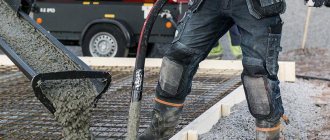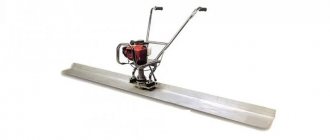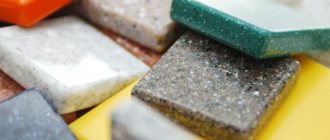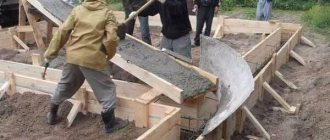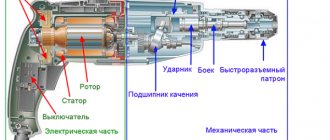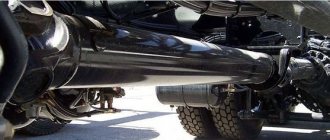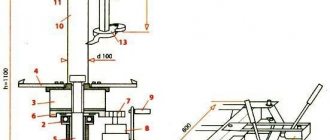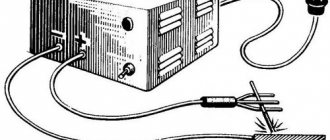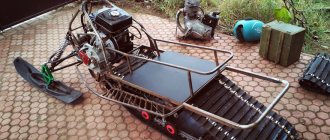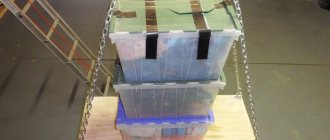The need to make a vibrator from a hammer drill appears during the pouring of the screed, foundation, and leveling of the concrete surface. The device is in demand for small-scale production or the creation of reinforced concrete structures at home. Instead of buying a ready-made vibrator for a hammer drill, it is easier and cheaper to make it yourself from materials found in a garage or scrap metal collection point.
Description of the vibrator for the hammer drill
A vibrator is a specific device used during construction work using cement mortars. It improves the quality of the pour: it compacts the structure of the future structure, eliminates air gaps in it, removes excess moisture, and slightly speeds up the construction of buildings. This means it reduces construction costs.
When pouring concrete, the mixture is saturated with air, especially if there is not enough liquid in it. A mass of air-filled voids is formed inside the composition, which reduces the strength and other characteristics of the material and its service life.
If a vibrator was not found at a construction site a decade or two ago, it was replaced by the manual bayonet method. Workers used improvised means, such as fittings and pipes, to bayonet the solution. This approach is very costly and ineffective. It is more advisable to use electric traction. At any construction site there is a hammer drill from which you can make a vibrator for concrete in ten minutes.
The vibrating tip is represented by an attachment for a hammer drill:
- The deep concrete vibrating tip is attached to the motor of a rotary hammer or drill through a flexible shaft and vibrates at high frequency and low amplitude, spreading vibration through the concrete.
- The surface vibrator for concrete is inserted into the chuck like a drill. The hammer drill operates in impact mode - it transmits mechanical vibrations from the impact mechanism to the formwork with concrete.
The principle of operation is to destroy the bonds between the molecules of the concrete solution, as a result of which air bubbles filling the voids are removed. Excess moisture, being lighter than the other components of the mixture, rises to the top.
The device gives concrete the required degree of density and fluidity, improves its mechanical and operational properties, and promotes uniform filling of voids with the mixture.
Assembling a vibrator with your own hands from a drill
If you need an internal vibrator, you can simply assemble it from an electric drill.
Before making a homemade vibrator for concrete, you need to understand what the operating principle of the device is based on.
An ordinary drill can be found in almost every home. The main driving force of such a device will be the transformation of rotational motion into oscillatory motion.
The main driving force of the device will be the most ordinary drill
Selecting material for vibrator assembly
To assemble such a device from a drill, any tool with a power of 1 kW or more is suitable. You will need an eccentric nozzle and a durable stainless steel tip. In addition, the following must be available:
- stainless steel tube 55 cm long and Ø 4 cm;
- metal rod Ø 15 mm;
- a piece of rectangular metal rod;
- two high-quality bearings and a bushing;
- bendable reinforced hose with waterproofing or durable rubber tube;
- internal rod for the tube (you can take the speedometer cable).
The mass of the eccentric creates a force that causes the attachment to oscillate at a certain frequency
Assembly tools
To assemble a vibrator you need to have a set of the following tools:
- set of metal drills;
- electric or gas welding;
- hacksaw;
- rectangular rod.
Stages of manufacturing a deep vibrator
The structure is assembled in the following order:
- We select a stainless steel tube about 40–60 cm long and Ø 3–4 cm. To construct the internal rod, you need to take a metal rod Ø 12–15 mm. It will shift the entire mechanism system in a certain direction and provide vibration vibrations. Since concrete is a very aggressive environment, stainless steel is the only suitable metal for making a vibrator.
A metal rod is used to make the internal axis
Bearings will allow the center piece to rotate freely
Bearings must be installed only of high quality
The quality of protection affects the durability of the vibrator
To make the job easier, you can use a cable from the car's speedometer
The hose must be tightly protected with a clamp
An electric drill is the optimal tool if you need to make a submersible concrete vibrator
Video: how to make a deep vibrator from a drill at home
Vibrator tasks
Regardless of the design and scope of application, a vibrator for concrete compaction must solve a number of problems for the builder:
- Increasing the strength of a structure by removing excess moisture and air bubbles from the mixture.
- Extending the service life of the structure.
- Making concrete homogeneous.
- Uniform filling of the formwork with mortar.
- Increasing the service life of reinforced concrete structures.
Additionally, the vibrating tip eliminates the need for layer-by-layer pouring of mortar, which speeds up the process of constructing reinforced concrete and concrete structures.
Which extender is better, factory or homemade?
Homemade extenders are significantly inferior to their factory counterparts
To better understand which device is better, you should compare the advantages and disadvantages of home-made and factory designs. Naturally, these data are averaged, and therefore they are relative.
| Criterion | Factory device | Do-it-yourself extender made at home |
| Dimensions | Ergonomic shape and compactness | Bulky design |
| Quality of materials | Hypoallergenic, medical | Unknown, may use toxic materials |
| Compliance | Products have passed certain clinical tests and have certificates of quality and compliance | Absent |
| Side effects | Not identified | Often |
| Price | From 1500 rubles and depends on the equipment of the device | Often low, determined by the quality of components |
As can be seen from the table, most homemade extenders are significantly inferior to their factory counterparts. At the same time, the cost of a budget model of a factory device is not high.
Types and design of vibrators
According to the method of transmitting mechanical vibrations - vibrations - to the mixture, concrete vibrators are divided into:
- Deep - the working part of the vibrating tip for the hammer drill is lowered into liquid concrete.
- Submersible - used for pouring walls, pillars - mounted vertically on formwork when working outdoors.
- Surface – compact horizontally poured concrete.
Assembled device
Structurally, a deep concrete vibrator is represented by an attachment or a vibrating tip connected to a hammer drill. Consists of four fundamental components:
- The drive that powers the vibration device is the power unit of the hammer drill.
- Flexible shaft.
- Protection made of durable rubber or other polymer material with similar properties.
- The tip, represented by a vibrating mace.
The last component has a mechanical effect on the cement mortar.
Also, according to their design, vibrating tips are divided into:
- Pendulum - the mechanism inside performs post-swimming and return movements with small amplitude.
- Eccentric - vibration is generated by a rotating shaft with an offset center.
Difference in design
Recommendations
Making a vibrator using the methods described are common options, although there are other methods. It is enough just to select the vibration source and then adapt the tip to it.
The main advantage of a homemade tool is that manufacturing is cheap, and after the work is completed, its main element can be used for its intended purpose. When assembling the equipment, it is necessary to make all joints reliable, since the concrete creates powerful pressure, actively counteracting vibrations.
Structure of a deep vibrator
A homemade deep concrete vibrator, made from a hammer drill, consists of the following components.
- Flexible transmission shaft up to several meters long, depending on the need and the power of the electric motor.
- Durable rubber seals installed between the hose with the cartridge and the mace - tip.
- The vibrating part can be cylindrical or conical - it tapers from the beginning, which is located at the hammer drill, to the end. The second form of vibrating attachment is used when working with a solution of increased density.
- The body is represented by a piece of stainless tube with bearings inside.
- A shaft with a displaced center of gravity is installed on the bearings, which generates the necessary mechanical vibrations. Their frequency depends on the design of the device and the rotation speed of the electric motor of the hammer drill.
A submersible vibrator from a rotary hammer operates at a frequency of 10,000 to 20,000 rpm; its shaft is reliably protected on top by a polymer material that does not allow water to pass through, for example, a rubber hose.
Miniature vibrating tips can be operated by one person; if the shaft is more than 1-2 meters long, an assistant is involved in the work.
By drive type
The engine is one of the main components of the vibrator.
Based on the type of drive, vibrators are distinguished:
Electromechanical.
Tied to the electrical network - single-phase (220 V) or three-phase network (380) - they have limited mobility. 220 V manual concrete vibrators do not require any special conditions, but do not provide much power. Models with a three-phase motor are more powerful, but heavier and more difficult to connect;
Compact submersible vibratory compactors are mobile - they are battery-powered (often powered from the mains is also provided). Disadvantages - limited operating time by the battery capacity and low power. Regardless of the price, compact models are intended for domestic use and do not involve processing large volumes of concrete.
Based on an internal combustion engine - gasoline or diesel.
The vibrators do not depend on the electrical network and have a power of up to 4 kW - this is enough for vibration processing of large-volume concrete masses. Disadvantages - large dimensions and weight, difficulty of maintenance.
There are portable models of gasoline vibrators for concrete. They are mobile - the engine fits in a backpack. However, they are more expensive than stationary ones, and the power usually does not exceed 2 kW.
Pneumatic.
The oscillatory force is created by supplying a stream of compressed air from the compressor. Pneumatic vibrators are used in industrial conditions - they have a long service life, are explosion- and electrically safe, do not require complex maintenance, and can operate in humid and dusty conditions. The main area of application is the production of reinforced concrete products.
Based on power, we can conditionally distinguish vibrators:
- household - up to 2 kW. These are stationary or more convenient (and expensive) portable models - working with them does not require special knowledge and experience;
- professional – up to 4 kW. Heavy and, as a rule, stationary models, the maintenance of which requires special skills. Such vibrators are used for laying concrete in multi-story and industrial construction, and in the production of reinforced concrete.
